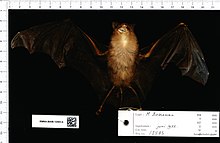Biak roundleaf bat
| Biak roundleaf bat | |
|---|---|

| |
| Scientific classification | |
| Kingdom: | Animalia |
| Phylum: | Chordata |
| Class: | Mammalia |
| Order: | Chiroptera |
| Family: | Hipposideridae |
| Genus: | Hipposideros |
| Species: | H. papua
|
| Binomial name | |
| Hipposideros papua | |

| |
| Biak roundleaf bat range | |
| Synonyms | |
| |
The Biak roundleaf bat or Geelvinck Bay leaf-nosed bat (Hipposideros papua) is a species of bat in the family Hipposideridae. It is endemic to the Biak Islands (Schouten Islands) and Cenderawasih Bay (Geelvinck Bay) area of Papua Province, located in Western New Guinea, Indonesia.
Taxonomy and etymology[]
It was described as a new species in 1886 by British zoologist Oldfield Thomas and Italian naturalist Giacomo Doria. They initially placed it in the now-defunct genus Phyllorhina, with the scientific name Phyllorhina papua. Its species name "papua" references Papua New Guinea where Odoardo Beccari collected the holotype.[2]
Description[]
It has a forearm length of approximately 50.5 mm (1.99 in). It has a nose-leaf with two lateral leaflets.[3]
Biology and ecology[]
It is nocturnal, roosting in sheltered places during the day such as caves.[1]
Range and habitat[]
It is endemic to Indonesia. Its range encompasses several islands of Indonesia, including Halmahera, Bacan, Gebe, Biak, Supiori, Numfoor, and Vogelkop Peninsula of New Guinea.[1]
Conservation[]
As of 2008, it is evaluated as least concern by the IUCN—its lowest conservation priority. It meets the criteria for this assessment because it is locally common within its range. Its habitat is unlikely to be rapidly declining in extent and quality, and its population trend is projected as stable.[1]
References[]
- ^ Jump up to: a b c d Helgen, K. (2008). "Hipposideros papua". IUCN Red List of Threatened Species. 2008: e.T10107A3165499. doi:10.2305/IUCN.UK.2008.RLTS.T10107A3165499.en.
- ^ Thomas, O.; Doria, G. (1886). "Note intoruo ad alcuni Chirotteri appartenenti al Museo Civico di Genova e descrizione di due nuove specie del genere Phyllorhina". Annali del Museo Civico di Storia Naturale di Genova. 2. 24: 204–206.
- ^ Tate, G. H. H. (1941). "A review of the genus Hipposideros with special reference to Indo-Australian species". Bulletin of the AMNH. 78: 37. hdl:2246/1780.
- IUCN Red List least concern species
- Hipposideros
- Bats of Indonesia
- Endemic fauna of Indonesia
- Mammals of Western New Guinea
- Least concern biota of Asia
- Least concern biota of Oceania
- Mammals described in 1886
- Taxa named by Giacomo Doria
- Taxa named by Oldfield Thomas
